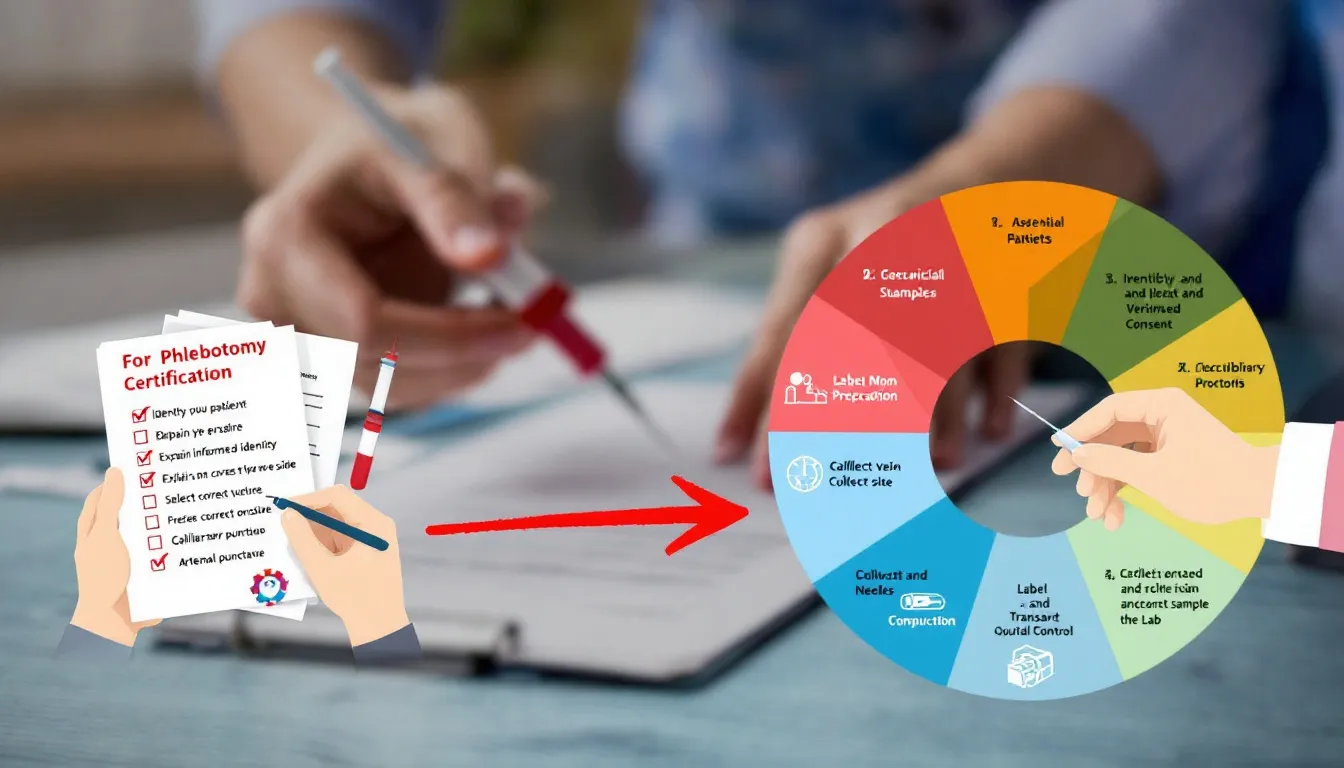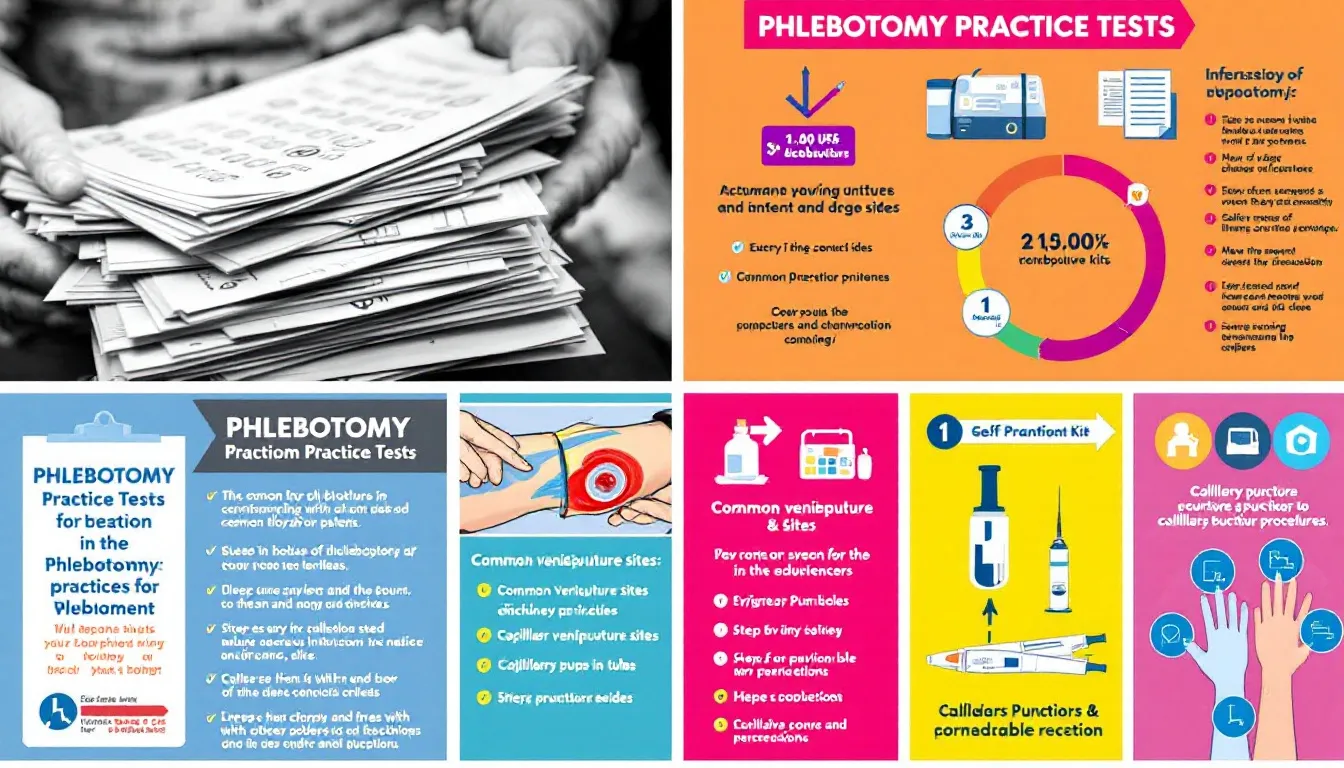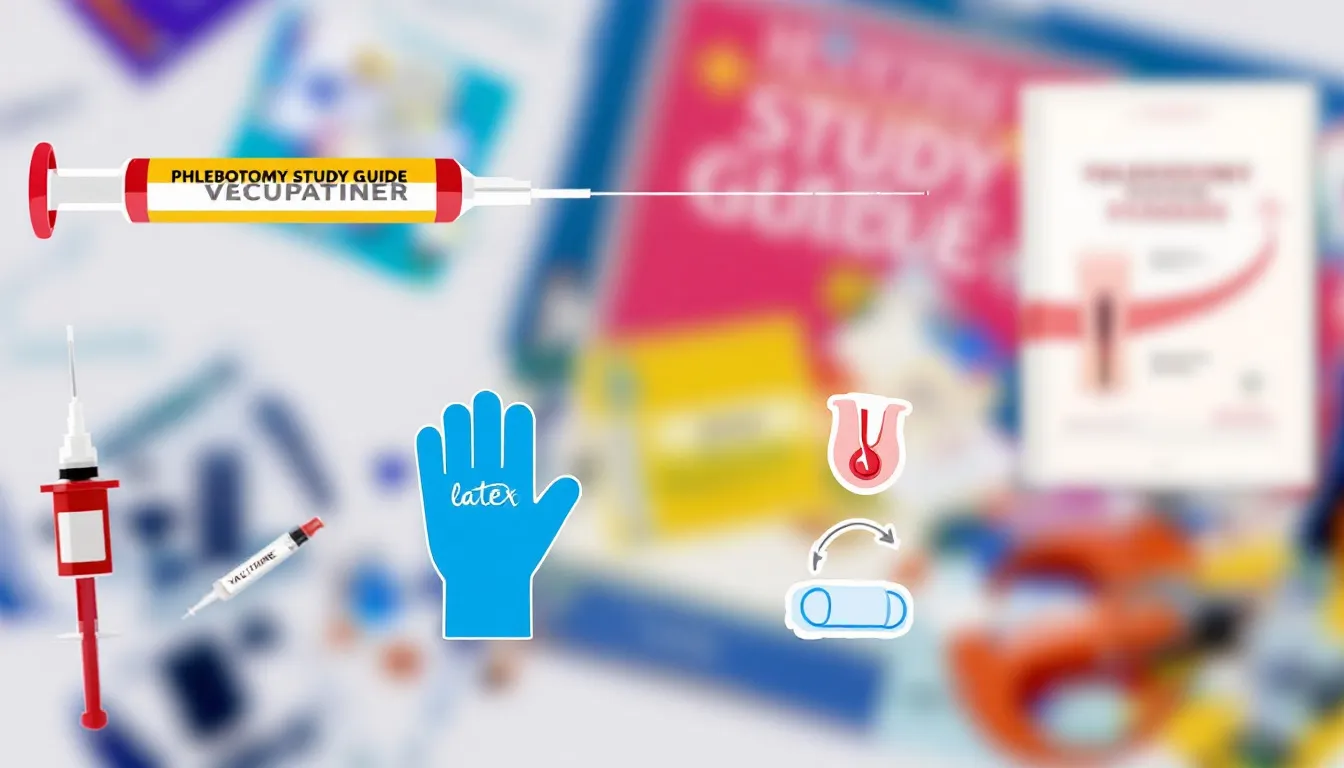Best Practice Test for Phlebotomy: Excel in Your Certification Exam
Looking for a practice test for phlebotomy to ace your certification exam? This guide covers the best practice tests for phlebotomy, explains how to use them, and prepares you for the exam.
Key Takeaways
- Phlebotomy certification exams evaluate essential skills in blood collection, patient safety, and infection control, with specific formats depending on the certifying body.
- Effective study strategies include using multiple-choice questions, scenario-based questions, flashcards, and simulated practice exams to enhance preparedness and identify knowledge gaps.
- Utilizing free resources and comprehensive study guides can significantly improve exam readiness while also providing a cost-effective strategy for candidates.
Understanding Phlebotomy Certification Exams

Phlebotomy certification exams are designed to validate your competency in blood collection and patient safety. These exams consist of around 125 questions, varying slightly depending on the certifying body. Organizations such as the National Healthcareer Association (NHA), American Society for Clinical Pathology (ASCP), American Medical Technologists (AMT), and the National Center for Competency Testing (NCCT) offer these certifications. The American Medical Certification Association (AMCA) also plays a significant role in phlebotomy certification, providing the Phlebotomy Technician Exam Certification. Each exam has different requirements, including the number of questions and time limits, like the NHA Certified Phlebotomy Technician exam, which allows up to 2 hours.
These certification tests assess your ability to perform essential phlebotomy tasks, including proper techniques for blood collection, understanding patient safety protocols, and adhering to clinical pathology standards. It’s not just about answering questions; it’s about demonstrating your readiness to handle the responsibilities of a phlebotomy technician.
Due to the differences in exam formats and requirements, understanding the specific details of your chosen certification exam is key. This knowledge allows you to tailor your study plan and concentrate on the most relevant areas.
What is Phlebotomy Certification?
Phlebotomy certification is a professional credential that validates an individual’s knowledge, skills, and competencies in the field of phlebotomy. This certification is a testament to a phlebotomist’s ability to collect blood samples safely and efficiently, handle specimens properly, and maintain patient safety and confidentiality. Various esteemed organizations, such as the American Society for Clinical Pathology (ASCP), the National Healthcareer Association (NHA), and the American Medical Technologists (AMT), offer phlebotomy certification. Achieving this certification not only enhances your credibility but also opens doors to more advanced career opportunities in clinical pathology and other healthcare settings.
Key Topics Covered
Phlebotomy certification exams encompass a variety of topics vital for competent practice. Specimen collection is a core area, testing your knowledge and skills in proper blood drawing and specimen handling. Grasping how equipment like the Vacutainer needle works, which allows for drawing multiple tubes of blood with a single venipuncture, is essential.
Infection control and safety are fundamental topics in these exams. Being well-versed in universal precautions to prevent contamination and ensure safety is necessary. Knowing about anticoagulants like sodium citrate, which prevents clotting by binding calcium in blood specimens, is essential. Additionally, understanding automated blood drawing systems like the Vacutainer System, which uses negative pressure for efficient specimen collection, is important.
Recognizing and managing conditions like thrombophlebitis, where a vein is inflamed due to clot formation, and addressing impaired blood flow caused by tortuous veins, are also critical topics.
Phlebotomy practice tests frequently feature multiple-choice and scenario-based questions to assess your knowledge. Familiarity with these question types enhances your study efforts and offers insight into the exam’s nature.
Types of Phlebotomy Practice Tests

Phlebotomy practice tests come in various forms, each designed to test different aspects of your knowledge and skills. These practice tests are crucial for building your proficiency and confidence as you prepare for the certification exam. The Ultimate Phlebotomy Practice Test, for instance, challenges you with a comprehensive set of questions that cover all essential areas of phlebotomy.
A variety of study aids can significantly enhance exam readiness. Multiple-choice questions, scenario-based questions, and flashcards help you cover a broad spectrum of topics for well-rounded preparation. The right study tools increase efficiency and boost confidence as you approach your certification exam.
Multiple-Choice Questions
Multiple-choice questions are a staple of phlebotomy practice tests, evaluating essential concepts like venipuncture techniques and specimen handling, which are central to the practice. Phlebotomy technicians play a crucial role in various medical facilities and must pass certification exams to qualify for their positions. For instance, understanding tissue bruising caused by an inaccurate gauge of needles or trauma from needle probing highlights the importance of mastering proper techniques.
Key concepts tested include using a tourniquet during venipuncture to restrict blood flow and enhance vein visibility. Additionally, differentiating between serum and plasma and recognizing conditions like lipemic blood samples caused by excessive lipids are important topics. Equipment like multi-sample adapters, which allow for multiple blood draws during venipuncture, is also frequently covered.
Simulated practice tests frequently offer randomized questions to keep your study experience engaging and challenging. This approach tests your knowledge and prepares you for the unpredictable nature of the actual exam. Immediate medical attention required for injuries caused by inaccurate needle draws and dealing with sclerosed veins are other scenarios you might encounter.
Scenario-Based Questions
Scenario-based questions test your ability to apply theoretical knowledge in realistic clinical situations, evaluating how you would respond to real-world challenges during your practice. For instance, you might need to handle a patient with difficult veins or manage an unexpected reaction during a blood draw.
Working through these scenarios helps develop problem-solving skills and the ability to think on your feet, essential traits for any phlebotomy technician. These questions aid in understanding the practical application of theoretical concepts and preparing for the unexpected in a clinical setting.
Flashcards and Cheat Sheets
Flashcards and cheat sheets are invaluable for quick review and memorization, helping you recall important terms and procedures in phlebotomy, thus making study sessions more efficient. For example, flashcards reviewing blood collection steps or types of anticoagulants can reinforce your memory and understanding.
Online resources provide a plethora of flashcards to reinforce key phlebotomy concepts. Regular review of these flashcards helps retain essential information more effectively. Using flashcards as a study aid promotes quick recall and solidifies a deeper understanding of phlebotomy practices.
Recommended Tools for Effective Phlebotomy Exam Preparation

Preparing for your phlebotomy certification exam requires the right tools to ensure comprehensive coverage of all necessary topics, including a phlebotomy prep course. Free resources, including practice questions, are widely available and can significantly enhance your study efficiency. Each practice question typically comes with detailed explanations to aid your understanding, making them an invaluable resource for exam preparation.
Appropriate tools like practice resources and structured study guides offer a significant advantage in preparing for phlebotomy exams. They help focus on areas needing improvement, ensuring well-rounded preparation and boosting confidence and readiness.
Simulated Practice Exams
Simulated practice exams are crucial for developing time management skills. Regular practice helps familiarize you with the exam format and question types, reducing anxiety and improving test day performance. Creating a daily schedule for your study sessions can help prioritize tasks and ensure all exam sections are addressed within the allotted time.
Using a checklist to enhance organization and maintain focus during practice exams is helpful. Detailed answer explanations in practice exams aid in understanding concepts and learning from mistakes, crucial for performance improvement.
Regular practice tests help identify weak areas, allowing you to focus study efforts more effectively.
Study Guides and Prep Courses
Comprehensive study guides and prep courses are invaluable for structured preparation, often including outlines that align with exam content areas to ensure all necessary topics are covered. Many study guides also include practice questions that mirror the actual exam content, providing a realistic practice experience.
Reviewing incorrect answers from practice tests helps identify knowledge gaps and enhances learning. Reflecting on mistakes provides insight into areas needing improvement, aiding retention and understanding. Analyzing incorrect answers is crucial for identifying knowledge gaps and reinforcing understanding.
Strategies for Acing Your Phlebotomy Practice Test
Effective strategies maximize performance on phlebotomy practice tests. Practicing stress-reduction techniques, like meditation, helps maintain well-being in high-pressure environments. The fast-paced nature of phlebotomy often leads to high stress levels and potential burnout. Building rapport with patients alleviates fears related to blood draws, creating a more comfortable environment for both the technician and the patient.
Effective communication skills are crucial for addressing patient concerns and ensuring comfort during procedures. Additional training empowers phlebotomists to handle challenging scenarios more effectively, enhancing preparedness for the certification exam. The qualifications and professional background of a critical care registered nurse, showcasing their education and ongoing involvement in the ICU and PACU, further emphasize the expertise and authority needed in the critical care field.
Time Management Techniques
Time management is critical for acing your phlebotomy practice test. Practice exams help familiarize you with the format and question types, enhancing speed and accuracy during the actual test. Allocating time wisely during the exam lets you focus on easier questions first, maximizing your score within the time limit.
Regular practice with timed exams develops a sense of timing and improves your ability to manage the exam efficiently. This approach boosts confidence and ensures completion of all test sections within the allotted time.
Review and Reflect
Reviewing and reflecting on practice test results is essential for continuous improvement. Many exam simulators provide immediate feedback, allowing for targeted improvements. Reviewing incorrect answers is crucial for identifying knowledge gaps and improving overall performance in phlebotomy exams.
Reflecting on mistakes in practice tests aids in learning from past errors and solidifies knowledge for future success. Understanding where you went wrong and focusing on those areas enhances preparedness and increases success chances in the certification exam.
Common Challenges in Phlebotomy Exams and How to Overcome Them
Phlebotomy exams have their own challenges, but the right strategies can overcome them. A common challenge is dealing with anxious patients or those with difficult veins, requiring patience and empathy. Strict adherence to procedures ensures patient safety and accurate test outcomes.
Multiple-choice questions in phlebotomy tests often assess understanding of patient safety and specimen collection techniques. The overwhelming nature of the test experience can also be a significant challenge. Reflecting on mistakes and developing strategies to avoid similar errors in the future helps mitigate these challenges and improve performance.
Phlebotomy Test Administration
Phlebotomy certification exams are administered by several reputable organizations, including the ASCP, NHA, and AMT. These exams are meticulously designed to assess a phlebotomist’s proficiency in critical areas such as blood collection, specimen handling, and patient safety. Each certifying body has its own specific requirements and formats, but all aim to ensure that certified phlebotomists are well-prepared to perform their duties with the highest standards of care and precision.
Test Fees and Payment
The fees for phlebotomy certification exams can vary depending on the certifying organization and the specific type of exam. Generally, the cost ranges from $100 to $300. Payment options are typically flexible, including credit cards, checks, and online payment platforms. It’s important to check with the specific certifying body for the most accurate and up-to-date fee information and payment methods.
Test Scheduling and Registration
Scheduling and registering for phlebotomy certification exams is a straightforward process that can be completed online or by phone. Candidates will need to provide their contact information, details about their education and work experience, and payment information. Once registered, candidates will receive a confirmation email or letter with the exam date, time, and location. This ensures that all necessary arrangements are in place for a smooth testing experience.
Phlebotomy Test Content
Phlebotomy certification exams cover a comprehensive range of topics essential for proficient practice. These exams typically include questions on:
- Blood collection techniques and procedures
- Specimen handling and processing
- Patient safety and confidentiality
- Infection control and prevention
- Medical terminology and anatomy
Understanding these areas is crucial for success in the exam and for performing effectively as a phlebotomy technician. Mastery of these topics ensures that you can handle the responsibilities of the role with confidence and competence.
Circulatory System
The circulatory system is a critical component of the human body, playing a vital role in maintaining homeostasis and overall health. It is responsible for transporting oxygen and nutrients to the body’s cells and removing waste products. The circulatory system consists of the heart, arteries, veins, and capillaries. For phlebotomists, having a basic understanding of the circulatory system is essential to collect blood samples safely and efficiently. Knowledge of how blood flows through the body and the locations of veins and arteries helps phlebotomists perform venipunctures accurately and minimize patient discomfort.
By integrating these new sections, the article now provides a more comprehensive guide to excelling in phlebotomy certification exams, covering everything from understanding the certification itself to the specifics of test administration and content.
Free Resources for Phlebotomy Practice Tests
Utilizing free resources for phlebotomy practice tests can significantly alleviate the financial burden of preparing for certification exams. The National Healthcareer Association offers free practice tests for those preparing for phlebotomy certification. Many websites and organizations provide free phlebotomy practice test and study materials online to assist candidates in their preparation.
Using free resources helps candidates save on costs and provides diverse practice opportunities to improve competencies in phlebotomy. These resources can supplement paid study aids, ensuring a comprehensive and cost-effective preparation strategy.
Summary
In summary, preparing for your phlebotomy certification exam requires a multifaceted approach. Understanding the structure and key topics of the exam, utilizing various types of practice tests, and employing effective study tools are all crucial steps in your preparation journey. By implementing strategies for time management and reflection, and overcoming common challenges, you can enhance your readiness and confidence for the exam.
Remember, the goal is not just to pass the exam but to become a competent and confident phlebotomy technician. With the right preparation and mindset, you can achieve your certification and excel in your career.
Frequently Asked Questions
How many people pass the phlebotomy exam?
Approximately 77.31% of candidates pass the CPT phlebotomy exam, based on 2022 statistics. This indicates a strong success rate among those pursuing phlebotomy certification.
How do I study for a phlebotomy test?
To effectively study for a phlebotomy test, utilize flashcards for memorization, review a reliable textbook, and take practice tests to enhance your exam skills. This comprehensive approach will boost your understanding and confidence for the test.
How many questions are on the phlebotomy exam?
The phlebotomy exam typically consists of 120 questions.
What are the key topics covered in the phlebotomy certification exam?
The phlebotomy certification exam covers key topics such as specimen collection, infection control and safety, the use of equipment like the Vacutainer needle, anticoagulant knowledge, and the recognition of conditions like thrombophlebitis and tortuous veins. Mastering these areas is essential for success in the exam.
How do multiple-choice questions in practice tests help with exam preparation?
Multiple-choice questions in practice tests enhance exam preparation by evaluating key concepts and familiarizing you with the exam format. This not only reinforces your knowledge but also builds confidence in essential techniques.

